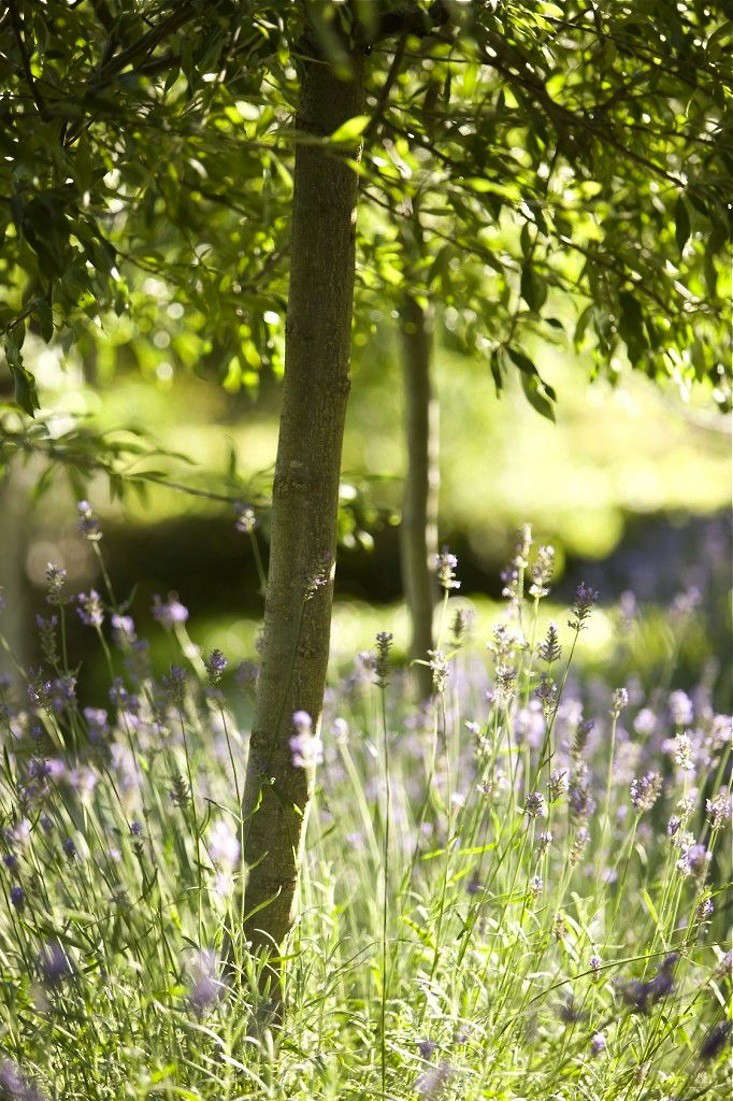My neighbor Bea has persuaded her family (including her husband, Scott, her two sons and a tiny dog) to live with less stuff than the average monk–and to produce no garbage. She’s a high priestess of garbage-free living who owns a single pair of jeans, takes meat jars to the butcher to prevent him from wrapping her order in paper, and avoids dental floss waste by using a brass gum stimulator with a metal tip.
Bea, a Mill Valley, CA blogger and the author of Zero Waste Home, also simplified her garden; here are her top ten tips for zero waste gardening:
Use Urine

Above: On Bea Johnson’s deck, a thriving potted lemon tree fertilized with pee. Photograph by Michelle Slatalla.
Fertilize your potted lemon trees with urine. “All you have to do is pee in the pot two or three times a year,” says Bea. “I didn’t realize how much of a difference it made until one of my sons stopped doing it in his tree and the leaves turned yellow. Scott peed in it, and boom, it’s back.”
Natives. Not.

Above: French lavender thrives in the similarly hot, sunny climate of Australia. Photograph via Peter Fudge.
Don’t grow natives just because you think you should. While natives sound good in theory, your garden has a particular climate all its own. “We spent hundreds of dollars on edible, native vegetables, and it was a nightmare, because they all got eaten or died,” says Bea. “I had to accept my limitations. Natives are very sensitive to their environment, and for example, it turns out the native thimbleberry raspberries I planted do well where it is quite moist in areas where there are redwoods. But our soil is ‘oaky,’ so they died.”
Ask for Advice

Above: A potted aloe plant in Bea’s kitchen. See How to Propagate Aloe Vera for tips on growing your own.
Get expert help to design a garden. It will save money in the long run. “After the natives died, I got a planting plan, for a garden that does not need much water or maintenance, and then Scott and I planted everything ourselves,” says Bea, who worked with Sausalito-based Shades of Green Landscape Architecture to come up with a list of plants suited to her dry, sunny hillside garden.
The low-water plants in Bea’s garden include fruitless blackberries, Berkeley sedge, New Zealand flax (“we got it because we wanted something really tall to cover the retaining wall behind where it was planted”), and asparagus ferns.
Organic Insecticide

Above: A bottle of Castile soap, for washing dishes, laundering clothes, and cleaning the house.
To repel garden pests, use a natural solution of Castile soap and water. (For Bea’s recipe, see DIY: The Best Insecticide, No Harmful Chemicals).
Seek Freebies

Above: If a friend is sprouting seeds, chances are there will be extras. Try trading. Photograph by John Merkl.
Get plants for free. “Often the same plants you are looking for are plants that other people want to get rid of,” says Bea. “Our oak tree fell and we wanted to replace it. One day I asked the friends I walk with on Wednesday mornings, ‘Anybody have a sapling?’ Not longer after, I was having a party and one of my friends brought a sapling to me as a hostess gift.”
Give Freely

Above: Photograph by Katie Newburn for Gardenista.
Give plants away for free. If you dig up something, post a notice on Craigslist–”Free Plants”–and leave it at the curb in a pot. “Someone will always come by,” says Bea.
Say No to Packaging

Above: A vertical wall of plants in Bea’s living room.
Avoid plastic packaging. If you are installing or adding to your drip irrigation system, buy pieces individually. Local stores will sell unpackaged irrigation pieces.
Harvest Your Dinner

Keep your garden shears handy so you can harvest whatever is ready to eat. “If they’re right there, in a drawer next to where you stand when you contemplate your garden, you are more likely to use them on a whim.”
Return Plastic Pots

Above: A closeup view of Bea’s indoor vertical garden.
Nurseries will take back pots. After you bring home plants, return the plastic containers so they can be re-used.
Bring Bags

Above: A reusable jute sack. For sources, see Natural Jute Garden Bags.
Take reusable bags to the store and fill them with bulk mulch to avoid plastic or paper bags.
Make Mulch

Above: Photograph by Michelle Slatalla.
If you have a pine tree, sweep up fallen needles and use them as a mulch; sprinkle needles over exposed soil to control weeds.
Above: Zero Waste Home by Bea Johnson is $14.50 from Amazon.
For more tips to simplify life, see :
- 10 Ways to Live With Less From Zero Waste Home
- 21 Tips: How to Save Water, One Drop at a Time
- 5 Favorites: Houseplants to Simplify Your Life









Have a Question or Comment About This Post?
Join the conversation